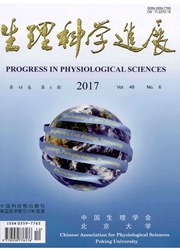

 中文摘要:
中文摘要:
纹状体(striatum)是机体运动中枢的关键组成部分,对机体随意运动、非意识性运动、肌张力、身体姿态、精细运动等调节均发挥重要作用。纹状体功能异常导致运动失调:一类为运动减少,肌张力亢进,如帕金森病;另一类为运动过多,肌张力不足,如舞蹈病。一般认为,纹状体接收大脑运动皮层传来的运动相关信号,经其加工处理后,经丘脑返传回运动皮层,最终由运动皮层发出运动执行信号,经锥体系完成运动。可见,纹状体的运动调控功能有赖于复杂的神经通路系统。本文综述近几年来有关纹状体神经通路与运动调控的研究进展,以期更深入理解纹状体运动调控神经机制及其与临床疾病的关系。
 英文摘要:
英文摘要:
Striatum is the central structure controlling movement. It plays a pivotal role in the regulation of voluntary movement, unconscious movement, muscle tone, posture adjustment and fine movement. Dysfunction of striatum causes a variety of movement disorders ranging from the hypokinetic disorders with increased muscle tone, such as Parkinson~ disease, to the hyperkinetic disorders with decreased muscle tone, such as Huntington~ disease. It is generally recognized that striatum receives the neural movement signals from the motor cortex, and then processes and modifies these signals and subsequently transfers the signals back to the motor cortex via thalamus for execution of the movement through pyramidal system. The movement control function of striatum depends on a complex neural circuit system. In this review, the studies on the movement control function of striatum as well as the striatal neural circuit system are summarized with an emphasis on the progress made during recent years for better understanding the mech- anism underlying the movement control function as well as the disease association of striatum.
 同期刊论文项目
同期刊论文项目
 同项目期刊论文
同项目期刊论文
 CART protects cerebral neurons against oxygen and glucose deprivation by CREB phosphoralytion and BD
CART protects cerebral neurons against oxygen and glucose deprivation by CREB phosphoralytion and BD 14,15-epoxyeicosatrienoic acid promotes production of BDNF from astrocytes and exerts neuroprotectiv
14,15-epoxyeicosatrienoic acid promotes production of BDNF from astrocytes and exerts neuroprotectiv 14,15-EET promotes mitochondrial biogenesis and protects cortical neurons against oxygen/glucose dep
14,15-EET promotes mitochondrial biogenesis and protects cortical neurons against oxygen/glucose dep ghrelin inhibiting the neuronal apoptosis induced by oxygen and glucose deprivation through upreguli
ghrelin inhibiting the neuronal apoptosis induced by oxygen and glucose deprivation through upreguli CART attenuates endoplasmic reticulum stress response induced by cerebral ischemia and reperfusion t
CART attenuates endoplasmic reticulum stress response induced by cerebral ischemia and reperfusion t Cocaine-and Amphetamine-regulated transcript facilitates the neurite outgrowth in cortical neurons a
Cocaine-and Amphetamine-regulated transcript facilitates the neurite outgrowth in cortical neurons a 期刊信息
期刊信息
